No-Till Case Study, Bauer Farm: Cover Crop Cocktails on Former CRP Land
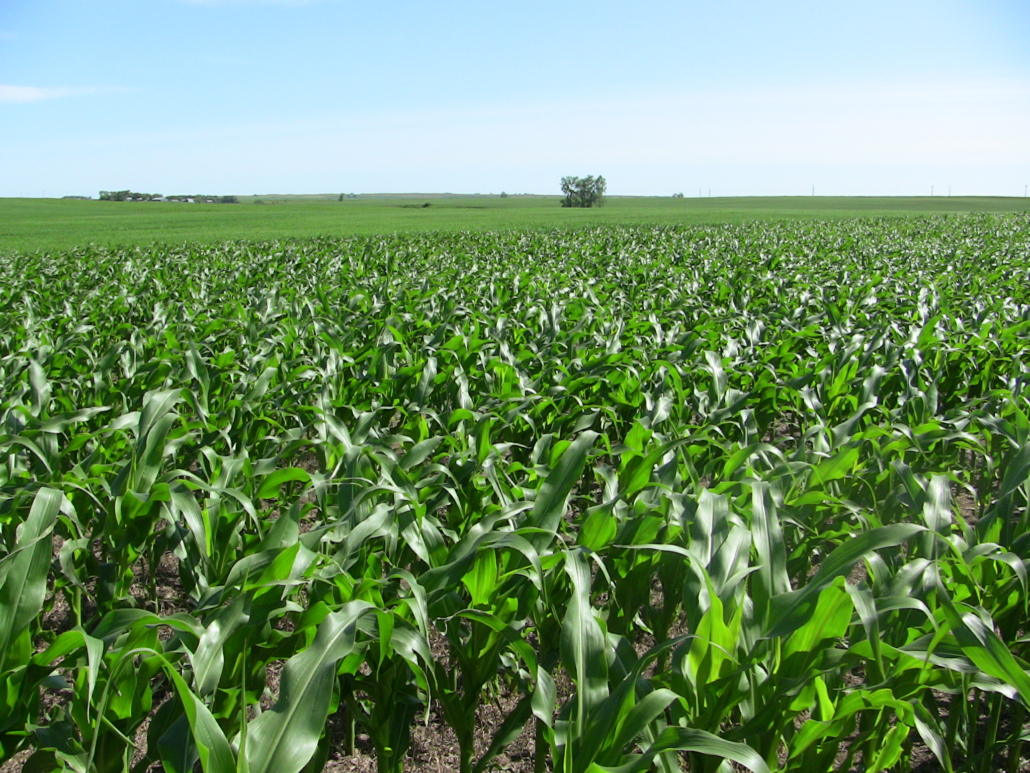
Corn crop after CRP. Photo: Susan Tallman, NCAT
By Susan Tallman, NCAT Agronomist
Abstract
The Bauer family in Bismarck, North Dakota, converted CRP land back to crop production. Their goal was to increase nutrient cycling and breakdown of old residue while maintaining the no-till benefits gained during the CRP period. To do this, they planted a low-carbon cover crop cocktail with no cool-season grasses. This publication relates the results of their experience.
Contents
Introduction
Converting CRP to Crop Production
Using a Cover Crop in Small Grain Production
2012 and Beyond
References
Further Resources
Introduction
Glenn Bauer, his wife Shirley, and sons Steve and Dave farm about 6,000 acres of small grains north of Bismarck, North Dakota. Although they are in Burleigh County, they are in a colder microclimate than other farmers in the county, with some risk of a late-August frost. As a result, their land is best suited to small grains and less suited for corn and soybean production. The soils on the Bauer farm are mainly in the Williams loam series.
Sixty percent of the crops they grow are hard wheat and durum wheat. Fifteen percent of their crops are yellow peas. They grow corn on 7% to 8% of their acreage. The rest of their crops are radish (for seed), millet, pinto beans, sunflower, buckwheat, flax, and soybeans.
Glenn started using a minimum-till system in 1984 when he purchased a Concord drill. In 2002, he switched to no-till when he purchased a disc-opener drill. The first few years he used the no-till system, the ground was still quite soft. However, as he continued with no-till, the soil became more resilient as it developed more structure.
Since switching to no-till, Glenn’s yields have gone up by 20 to 30 bushels per acre. Prior to using no-till, 35 bushels per acre was a respectable yield for the farm. In 2008, a year the farm received a good amount of precipitation, the average yield on their farm was 68 bushels per acre. One field of hard red spring wheat yielded 90 bushels per acre with 13.5% protein in 2008.
While Glenn’s yields have increased with no-till, the amount of inputs he uses has stayed the same. Even so, Glenn says that it has taken several years for the no-till system to work and for him to get some wrinkles ironed out of the system. For example, he used to have a problem with hairpinning during seedling emergence. Over time, that problem has diminished with the development of better soil structure.
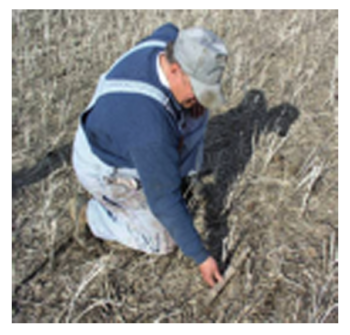
Three years of crop residue: corn, wheat, and canola. Photo: Jay Fuhrer, NRCS
Glenn also notes that seeding no-till wheat into chemical-fallow stubble is not a good no-till system. Following one small grain with another provides no diversity to the system and does not promote soil health. To manage a good no-till system effectively, a farmer has to think about crop rotation and diversity.
Unlike other farmers in the area, the Bauers do not have livestock. Their operation is devoted to crop production. As a result, their resource needs are different from other no-till farmers who have livestock. Specifically, the Bauers have an excessive amount of high-carbon crop residue on their fields. Their main resource concern is finding a way to break down this crop residue. Additionally, the Bauers still have a noticeable plow layer in their soil from tillage in previous years. This layer inhibits water infiltration and root growth. The Bauers would like to use cover crops to improve the soil quality of their crop land.
Converting CRP to Crop Production
The most recent challenge on the Bauer farm has been the conversion of land that has been in the Conservation Reserve Program (CRP) for many years to grain production. CRP is a USDA program that encourages farmers to convert highly erodible cropland or other environmentally sensitive acreage to vegetative cover, such as tame or native grasses, wildlife plantings, trees, filterstrips, or riparian buffers. Farmers receive an annual rental payment for the term of the multi-year contract. At the end of the contract, the owner has the option of agreeing to a new contract or returning the land to production. The Bauers had 107 acres of land that had been in CRP for 20 years, from 1986 until 2007. The plant species mix on this land was 90% brome grass (cool-season grass) and 10% alfalfa (warm-season broadleaf.)

Infiltration barriers. Photo: Jay Fuhrer, NRCS
The Bauers had three main goals in converting the CRP land. First, they wanted to make the conversion as economically as possible. Second, they wanted to maintain the soil structure, organic matter, and water infiltration ability that had been gained during the CRP years. Introducing any tillage to this land would reverse the results of two decades of no-till. Finally, they wanted to increase the plant diversity. For 20 years, the main plant species on this land had been a cool-season grass (brome). Because most of their crop production is also in cool-season grasses, the Bauers wanted to grow a cover crop with varied species to promote diversity in the soil biology.
The Bauers’ first step was to use glyphosate and dicamba to terminate the existing CRP stand in the fall of 2007. Next, they windrowed all the acreage and baled two-thirds of the residue. They used a combine harvester to gather the remaining one-third of the residue and to spread it evenly across the field with the straw spreaders.
After dealing with the residue, they made three shallow passes with a disc, being careful to run the disc only along the surface to smooth any mounds. After the discing, nothing more was done to the CRP field that year.
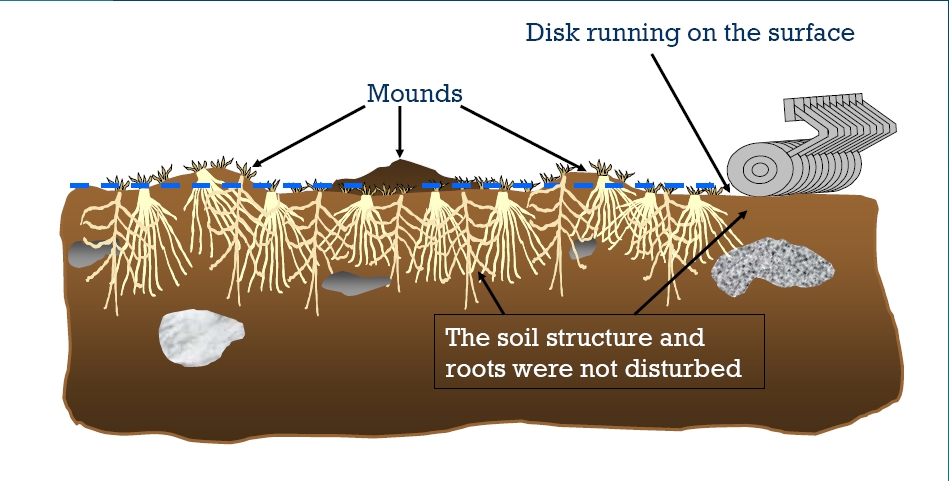
In the spring of 2008, the Bauers did one harrow pass and one roller pass and then seeded field peas with their no-till drill on April 30. Right after seeding, they rolled the field again. During the growing season, they made two herbicide applications for weed control and applied a desiccant prior to harvest. They harvested the pea crop on August 6.
Cover Crop Cocktail
Right after the pea harvest, on August 15, the Bauers seeded their first cover crop cocktail into the former CRP field. They used a mixture of eight species, some of which was seed they had on hand (to cut expenses). They used no fertilizer for the cover crop and assumed some residual nitrogen benefit would follow from the field peas.
Table 1. Composition of Cover Crop, 2008
| Species | Type | Seeding Rate (lb/acre) |
| Buckwheat | Warm season, broadleaf |
5 |
| Sunflower | Warm season, broadleaf |
5 |
| Pea | Cool season, broadleaf |
10 |
| Corn* | Warm season, grass |
0.1 |
| Red Proso Millet | Warm season, grass |
5 |
| Yellow Blossom Sweet Clover** | Warm season, broadleaf |
1 |
| Forage Radish | Cool season, broadleaf |
1 |
| Turnip | Cool season, broadleaf |
1 |
*Corn was leftover seed cleaned out of the shop.
** Glenn would recommend using either lentils or chickling vetch instead of YBSC in the future.

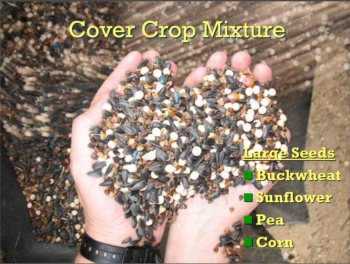
Cost Analysis
The Bauers figure that during the two years of conversion, they did just a little bit better than breaking even, earning $796 in total. They calculate their costs as detailed in Table 2 and Table 3. First, they spent around $4,000 in the Fall of 2007.
Table 2. Fall 2007 Operating Expenses
| Expenses | Acres | Unit Cost | Total |
| Glyphosate 1qt/ac and Dicamba 3 oz/ac | 107 | $ 4.25 | $ 454.75 |
| Spray application | 107 | $ 4.50 | $ 481.50 |
| Windrow | 107 | $ 5.00 | $ 535.00 |
| Combine | 37 | $ 10.00 | $ 370.00 |
| Baling (200 bales @ $6.00/bale) | 70 | $ 17.14 | $ 1,200.00 |
| No-Till disk (three passes) | 321 | $ 3.00 | $ 963.00 |
| TOTAL | $ 4004.25 |
Likewise, the Bauers calculated the cost for growing the peas and cover crop in 2008.
Table 3. 2008 Operating Expenses
| Expenses | Unit Cost | x 107 acres = TOTAL |
| Harrow | $ 3.00 | $ 321.00 |
| Roller | $ 4.00 | $ 428.00 |
| Pea seed (3.7 bu/ac @ $9.00/bu) | $ 33.30 | $ 3563.10 |
| Fertilizer | 0 | 0 |
| Tag Team inoculant | $ 7.50 | $ 802.50 |
| Seeding | $ 12.00 | $ 1284.00 |
| Roller | $ 4.00 | $ 428.00 |
| Spartan (pre-emergent) | $ 11.24 | $ 1202.68 |
| Spray application | $ 4.50 | $ 481.50 |
| Rezult (growing season) | $ 11.00 | $ 1177.00 |
| Spray application | $ 4.50 | $ 481.50 |
| Gramoxone (desiccant) | $ 5.75 | $ 615.25 |
| Spray application | $ 4.50 | $ 481.50 |
| Combine | $ 15.00 | $ 1605.00 |
| Cover crop seed | $ 10.38 | $ 1110.66 |
| Cover crop seeding | $ 12.00 | $ 1284.00 |
| TOTAL | $ 15,265.69 |
Taken together, the total expenses were $19,270. How does this compare with the income over the same time? Table 4 details the income during this period.
Table 4. CRP Conversion Income, 2007 – 2008
| Source | Acres | Yield | Unit Income | Total Income |
| Hay Bales | 70 | 2.86 bales/acre | $ 20 / bale | $ 4,000 |
| Pea Harvest | 107 | 18.2 bu/acre | $ 8.25 /bu | $16,066 |
| TOTAL | $ 20, 066 |
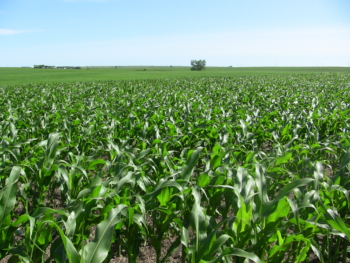
Corn crop after CRP. Photo: Susan Tallman, NCAT
When income and expenses are considered together, the Bauers ended up $796 ahead at the end of 2008. In addition, they were able to make this conversion to cropland in only one and a half crop years, compared with the three years it usually takes to fully decompose CRP residue prior to successful cropping. In addition, the Bauers were very pleased to have not used any tillage in the conversion process. This allowed them to conserve the beneficial soil structure provided by the 20 years in CRP.
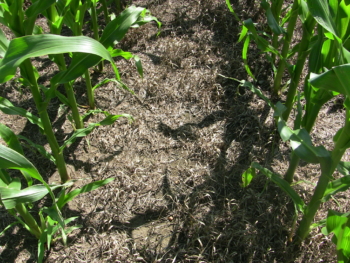
Residue in corn field. Photo: Susan Tallman, NCAT
The Bauers allowed the cover crop to winterkill and planted corn in the spring of 2009. The corn was harvested for grain in the fall, with a yield of 80 bushels per acre. While this is 20% less than the county average of 100 bushels per acre, Glenn was happy with the crop, as it yielded only slightly less than his other dryland corn fields that year. In 2012, the field was in full crop production and it now yields similarly to the Bauers’ other acreage.
Using a Cover Crop in Small Grain Production
In addition to using a cover crop cocktail to convert CRP ground, the Bauers tried a cover crop cocktail in their existing grain fields in the fall of 2008. Following the harvest of a yellow pea crop at the end of July, they seeded about 1,000 acres during the first part of August with the same cover crop mixture used in the CRP field. (See Table 1 above.)
Glenn wanted to try this strategy on his existing fields for residue management because there was too much grain straw on his fields from one year to the next. In these fields, Glenn’s main resource concern was to encourage more rapid breakdown of crop residue for improved nutrient cycling.

Wheat residue without prior cover crop. Photo: Susan Tallman, NCAT
The Bauers seeded the cover crop when the field was dry; as a result, the cover crop did not emerge until a few weeks after planting, when some timely rains arrived. This cover crop grew from about the third week of August to the middle of October, and was allowed to winterkill as a termination strategy. Some of the field was not planted with a cover crop, in order to provide a comparison that would show the effects of the cover crop on spring wheat the following year.
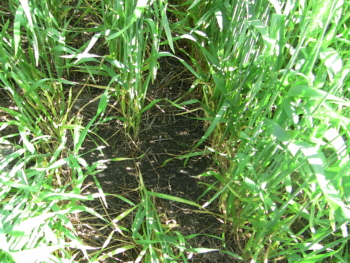
Wheat residue with prior cover crop. Photo: Susan Tallman, NCAT
Glenn planted a cash crop of spring wheat in 2009. A field visit in July of 2009 showed less residue in the field with the cover crop than in the field without the cover crop.
These photos were taken on July 17, 2009. Notice there is a definite difference in the residue levels in the two fields.
Both fields were fertilized equally over the course of the year, with an initial N application at seeding, then another N application at the four-leaf stage. In the field, the wheat in the cover crop field seemed to look better, with longer heads and a thicker stand. However, when the wheat was harvested, both fields yielded almost the same, at about 80 bushels per acre. Glenn had expected the wheat with the prior cover crop would yield 5 to 10 bushels per acre more, but that was not the case. In fact, the wheat with the cover crop had a test weight of about 58 pounds per bushel, while the wheat without the cover crop had a test weight of 60 pounds per bushel, indicating that the cover crop used too much soil water.
Results from green manure studies in other locations in the Northern Great Plains confirm this is a likely result after a one-year study. Recent work in Montana showed that wheat yields decreased on average by four bushels per acre after the first year of a green manure crop (O’Dea, 2011). Other studies have suggested that cover crops must be part of a long-term strategy, with positive results not seen until the sixth or eighth year of a rotation with wheat (Zentner et al., 2004). In this case, Glenn only tried the cover crop prior to wheat this one time. It would be interesting to try this technique for a five- to10-year period to see if positive results were obtained.
2012 and Beyond
Glenn Bauer believes that cover crop cocktails are best used in combination with livestock and prior to a corn crop. In the late summer of 2011, his son planted a cover crop cocktail and then terminated the cover crop in the late fall with cattle grazing. This was a late-season cover crop similar to the one used for the CRP conversion. A portion of the field was not planted with a cover crop, nor was it grazed, in order to provide for comparisons. In 2012, he planted a crop of corn on both parts of the field and fertilized both equally. In September 2012, the corn crop following the cover crop and grazing yielded about 100 bushels per acre, while the field of corn with no cover crop and no grazing yielded about 83 bushels per acre.
Glenn is also experimenting with a longer, full-season cover crop cocktail prior to a wheat crop. He believes that growing a cover crop for a full season may provide more benefit to a subsequent wheat crop than a short-season cover crop would. In late May of 2012, he planted a cover crop cocktail on a section of land (640 acres) with a mixture of turnip, radish, buckwheat, barley, and sweet clover. He divided the section into 10 paddocks and turned in 70 head of cattle in the last part of July. The cattle rotated through the paddocks until the end of September, receiving two months of forage from the cover crop. A portion of this section had no cover crop or grazing, so that Glenn could make comparisons between the treatments. Next year (2013), Glenn will plant a crop of wheat on the section to see if there are any differences in wheat response after this treatment.
Glenn hopes to figure out how best to integrate cover crop cocktails into a small grain system. He has concluded that the full benefit of a cover crop cocktail is realized only when livestock are integrated into the system. Farms with only a crop component are missing the full value of the cocktail. Glenn continues to experiment with ways to improve soil health and biodiversity on his farm.
References
O’Dea, J.K. 2011. Greening Summer Fallow: Agronomic and Edaphic Implications of Legumes in Dryland Wheat Agroecosystems. Land Resources and Environmental Sciences, Montana State University, Bozeman, MT.
Zentner R.P., C.A. Campbell, V.O. Biederbeck, F. Selles, R.Lemke, P.G. Jefferson, and Y. Gan Y. 2004. Long-term Assessment of Management of an Annual Legume Green Manure Crop for Fallow Replacement in the Brown Soil Zone. Canadian Journal of Plant Science. Vol. 84. p.11-22.
Further Resources
Burleigh County Soil Conservation District
The Manitoba North Dakota Zero Tillage Farmers Association
Innovative No-Till: Using Multi-Species Cover Crops to Improve Soil Health
A National Center for Appropriate Technology webinar
Farming in the 21st Century: Soil Health
No-Till Case Study, Bauer Farm: Cover Crop Cocktails on Former CRP Land
By Susan Tallman, NCAT Agronomist
Published October 2012
© NCAT
IP442
This publication is produced by the National Center for Appropriate Technology through the ATTRA Sustainable Agriculture program, under a cooperative agreement with USDA Rural Development. ATTRA.NCAT.ORG.


